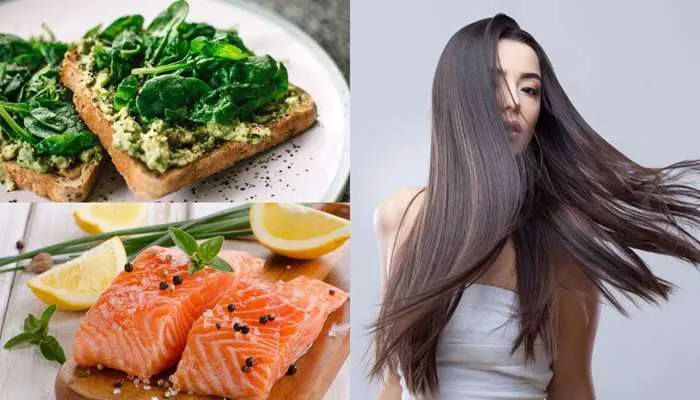As a hairstylist, I’ve seen firsthand how diet impacts hair health. Thick, strong hair isn’t just about using the right products—it starts inside your body. Nutrients from food fuel hair growth, strengthen strands, and prevent thinning. In this guide, I’ll explain exactly what to eat to boost thickness, using simple, science-backed advice. Let’s dive in!
Why Does Diet Affect Hair Thickness?
Hair is made of keratin, a protein that relies on vitamins, minerals, and fats to grow. Poor nutrition starves hair follicles, leading to weak, thin strands. For example:
- Protein deficiency causes hair to enter a “resting phase,” slowing growth.
- Low iron or zinc disrupts the hair growth cycle, increasing shedding.
- Lack of healthy fats dries out the scalp, causing breakage.
By eating nutrient-rich foods, you nourish follicles, promote growth, and protect existing hair.
Key Nutrients for Thicker Hair (And Where to Find Them)
Below are the most important nutrients for thick hair, along with food sources and how they work.
Protein
Why it matters: Hair is 95% protein. Without enough, strands become brittle and thin.
Best sources:
- Eggs: Packed with protein and biotin (more on this later!).
- Chicken, turkey, or lean beef: High in iron and zinc.
- Lentils or beans: Plant-based protein with fiber.
- Greek yogurt: Contains casein, a slow-digesting protein that supports long-term growth.
Tip: Aim for 20–30 grams of protein per meal.
Biotin (Vitamin B7)
Why it matters: Biotin strengthens keratin and prevents split ends. Low levels cause hair loss.
Best sources:
- Egg yolks: One egg provides 33% of your daily biotin.
- Almonds: Snack on a handful daily.
- Sweet potatoes: Rich in biotin and beta-carotene (converts to vitamin A).
- Salmon: Contains biotin and omega-3s.
Note: Biotin works best with other B vitamins like B12 (found in meat or fortified cereals).
Omega-3 Fatty Acids
Why they matter: Omega-3s reduce scalp inflammation, moisturize hair, and add shine.
Best sources:
- Fatty fish: Salmon, mackerel, or sardines (2–3 servings weekly).
- Chia seeds or flaxseeds: Sprinkle on oatmeal or smoothies.
- Walnuts: A plant-based omega-3 source.
Bonus: Omega-3s also support heart and brain health!
Iron
Why it matters: Iron carries oxygen to hair follicles. Deficiency is a leading cause of thinning.
Best sources:
- Red meat: Easily absorbed “heme” iron.
- Spinach or kale: Pair with vitamin C (e.g., lemon juice) to boost absorption.
- Lentils or tofu: Great for vegetarians.
- Dark chocolate: A tasty iron-rich treat (choose 70%+ cocoa).
Warning: Low iron causes fatigue and pale skin—get levels checked if hair is shedding.
Zinc
Why it matters: Zinc repairs hair tissue and regulates oil glands. Deficiency leads to dryness and dandruff.
Best sources:
- Oysters: Just 2 oysters provide 100% of your daily zinc.
- Pumpkin seeds: Sprinkle on salads or yogurt.
- Chickpeas: Add to soups or hummus.
- Beef: A 3-ounce serving covers 40% of your zinc needs.
Vitamin D
Why it matters: Vitamin D activates hair follicles. Low levels are linked to alopecia.
Best sources:
- Sunlight: 10–15 minutes of sun exposure daily.
- Mushrooms: Place them in sunlight to boost vitamin D.
- Fortified milk or orange juice.
- Cod liver oil: A potent supplement (consult a doctor first).
Vitamin E
Why it matters: Vitamin E is an antioxidant that protects hair from sun and pollution damage.
Best sources:
- Sunflower seeds: A quarter-cup provides 80% of your daily needs.
- Avocado: Blend into smoothies or spread on toast.
- Almond butter: Swap for peanut butter.
- Spinach: Sauté with garlic for a tasty side.
Vitamin A
Why it matters: Vitamin A produces sebum, the scalp’s natural oil. Too little causes dryness; too much can be toxic.
Best sources:
- Carrots or sweet potatoes: Rich in beta-carotene (converts to vitamin A safely).
- Kale or collard greens: Steam or bake into chips.
- Liver: Eat sparingly (1–2 times monthly).
Selenium
Why it matters: Selenium fights free radicals and supports thyroid health (hormones impact hair growth).
Best sources:
- Brazil nuts: Just 2 nuts provide 100% of your daily selenium.
- Tuna or shrimp: Easy to add to salads.
- Brown rice: A fiber-rich selenium source.
Caution: Don’t overdo selenium—too much causes hair loss.
Silica
Why it matters: Silica strengthens hair’s structure and prevents breakage.
Best sources:
- Cucumbers: Eat with the skin on.
- Bell peppers: Slice raw into snacks.
- Oats: Start your day with oatmeal.
Sample Meal Plan for Thicker Hair
Here’s a 1-day example of hair-boosting meals:
Breakfast:
- Spinach omelet (eggs + spinach + olive oil).
- Greek yogurt with blueberries and chia seeds.
Lunch:
- Grilled salmon salad (mixed greens + avocado + pumpkin seeds).
- Quinoa on the side.
Snack:
- Carrot sticks with hummus.
- Handful of almonds.
Dinner:
- Stir-fried chicken with broccoli and bell peppers.
- Brown rice.
Dessert:
- Dark chocolate square (70% cocoa).
Foods to Avoid for Thicker Hair
Some foods harm hair health:
Sugar: Spikes insulin, which may disrupt hair growth hormones.
Processed carbs: White bread or pastries lack nutrients and cause inflammation.
Alcohol: Dehydrates hair and depletes zinc.
High-mercury fish: Swordfish or king mackerel may worsen hair loss.
Lifestyle Tips to Boost Results
- Stay hydrated: Water keeps hair follicles active.
- Manage stress: Chronic stress triggers hair loss. Try yoga or meditation.
- Avoid tight hairstyles: Ponytails or braids can pull out hair over time.
- Trim regularly: Prevents split ends from traveling up the shaft.
Conclusion
Thicker hair starts with a balanced diet rich in protein, vitamins, and minerals. Focus on whole foods like eggs, leafy greens, nuts, and fatty fish. Pair this with good hydration and stress management for best results. Remember, hair grows slowly—stick with these changes for at least 3–6 months to see a difference.
Related topics:
What Should I Eat To Make My Hair Thicker
How Can You Achieve a Perfect Hairline?
What Is Sapphire Hair Transplant and How Does It Work?


